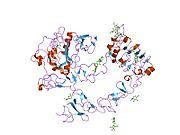Epidermal growth factor
Template:PBB Epidermal growth factor or EGF is a growth factor that stimulates cell growth, proliferation, and differentiation by binding to its receptor EGFR. Human EGF is a 6045-Da protein with 53 amino acid residues and three intramolecular disulfide bonds.[1]
History
The discovery of EGF won Stanley Cohen of Vanderbilt University a Nobel Prize in Physiology and Medicine in 1986[2].
Function
EGF results in cellular proliferation, differentiation, and survival.[3] EGF is a low-molecular-weight polypeptide first purified from the mouse submandibular gland, but since then found in many human tissues including submandibular gland, parotid gland. Salivary EGF, which seems also regulated by dietary inorganic iodine, also plays an important physiological role in the maintenance of oro-esophageal and gastric tissue integrity. The biological effects of salivary EGF include healing of oral and gastroesophageal ulcers, inhibition of gastric acid secretion, stimulation of DNA synthesis as well as mucosal protection from intraluminal injurious factors such as gastric acid, bile acids, pepsin, and trypsin and to physical, chemical and bacterial agents.[4]
Biological Sources
Epidermal growth factor can be found in human platelets, macrophages, urine, saliva, milk, and plasma.[5]
Mechanism

EGF acts by binding with high affinity to epidermal growth factor receptor (EGFR) on the cell surface and stimulating the intrinsic protein-tyrosine kinase activity of the receptor (see the second diagram). The tyrosine kinase activity, in turn, initiates a signal transduction cascade that results in a variety of biochemical changes within the cell - a rise in intracellular calcium levels, increased glycolysis and protein synthesis, and increases in the expression of certain genes including the gene for EGFR - that ultimately lead to DNA synthesis and cell proliferation.[6]
EGF-family
EGF is the founding member of the EGF-family of proteins. Members of this protein family have highly similar structural and functional characteristics. Besides EGF itself other family members include:[7]
- Heparin-binding EGF-like growth factor (HB-EGF)
- transforming growth factor-α (TGF-α)
- Amphiregulin (AR)
- Epiregulin (EPR)
- Epigen
- Betacellulin (BTC)
- neuregulin-1 (NRG1)
- neuregulin-2 (NRG2)
- neuregulin-3 (NRG3)
- neuregulin-4 (NRG4).
All family members contain one or more repeats of the conserved amino acid sequence:
Where X represents any amino acid.[7]
This sequence contains 6 cysteine residues that form three intramolecular disulfide bonds. Disulfide bond formation generates three structural loops that are essential for high-affinity binding between members of the EGF-family and their cell-surface receptors.[8]
EGF therapy
Because of the increased risk of cancer by EGF, inhibiting it decreases cancer risk.[3] Such medications are so far mainly based on inhibiting the EGF receptor. Monoclonal antibodies are potential substances for this purpose.
Interactions
Epidermal growth factor has been shown to interact with Epidermal growth factor receptor[9][10] and PIK3R2.[11]
References
- ^ Carpenter G, Cohen S (1990). "Epidermal growth factor". The Journal of Biological Chemistry. 265 (14): 7709–12. PMID 2186024.
{{cite journal}}: Unknown parameter|month=ignored (help) - ^ Hall K (1986). "The Nobel Prize in Physiology or Medicine 1986 - Presentation Speech". The Nobel Foundation. Retrieved 2009-04-24.
{{cite web}}: Cite has empty unknown parameter:|coauthors=(help) - ^ a b Herbst RS (2004). "Review of epidermal growth factor receptor biology". International Journal of Radiation Oncology, Biology, Physics. 59 (2 Suppl): 21–6. doi:10.1016/j.ijrobp.2003.11.041. PMID 15142631.
- ^ Venturi S.; Venturi M. (2009). "Iodine in evolution of salivary glands and in oral health". Nutrition and Health. 20 (2): 119–134. doi:10.1177/026010600902000204. PMID 19835108.
- ^ Cotran, Ramzi S.; Kumar, Vinay; Fausto, Nelson; Nelso Fausto; Robbins, Stanley L.; Abbas, Abul K. (2005). Robbins and Cotran pathologic basis of disease. St. Louis, Mo: Elsevier Saunders. ISBN 0-7216-0187-1.
{{cite book}}: CS1 maint: multiple names: authors list (link) - ^ Fallon JH, Seroogy KB, Loughlin SE, Morrison RS, Bradshaw RA, Knaver DJ, Cunningham DD (1984). "Epidermal growth factor immunoreactive material in the central nervous system: location and development". Science. 224 (4653): 1107–9. doi:10.1126/science.6144184. PMID 6144184.
{{cite journal}}: Unknown parameter|month=ignored (help)CS1 maint: multiple names: authors list (link) - ^ a b Dreux AC, Lamb DJ, Modjtahedi H, Ferns GA (2006). "The epidermal growth factor receptors and their family of ligands: their putative role in atherogenesis". Atherosclerosis. 186 (1): 38–53. doi:10.1016/j.atherosclerosis.2005.06.038. PMID 16076471.
{{cite journal}}: Unknown parameter|month=ignored (help)CS1 maint: multiple names: authors list (link) - ^ Harris RC, Chung E, and Coffey RJ. (2003). "EGF receptor ligands". Exp. Cell. Res. 284 (1): 2–13. doi:10.1016/S0014-4827(02)00105-2. PMID 12648462.
{{cite journal}}: CS1 maint: multiple names: authors list (link) - ^ Stortelers, Catelijne (2002). "Role of the N-terminus of epidermal growth factor in ErbB-2/ErbB-3 binding studied by phage display". Biochemistry. 41 (27). United States: 8732–41. doi:10.1021/bi025878c. ISSN 0006-2960. PMID 12093292.
{{cite journal}}: Check date values in:|year=(help); Cite has empty unknown parameters:|laydate=,|laysummary=, and|laysource=(help); Unknown parameter|coauthors=ignored (|author=suggested) (help); Unknown parameter|month=ignored (help) - ^ Wong, L (1999). "A differential requirement for the COOH-terminal region of the epidermal growth factor (EGF) receptor in amphiregulin and EGF mitogenic signaling". J. Biol. Chem. 274 (13). UNITED STATES: 8900–9. doi:10.1074/jbc.274.13.8900. ISSN 0021-9258. PMID 10085134.
{{cite journal}}: Check date values in:|year=(help); Cite has empty unknown parameters:|laydate=,|laysummary=, and|laysource=(help); Unknown parameter|coauthors=ignored (|author=suggested) (help); Unknown parameter|month=ignored (help)CS1 maint: unflagged free DOI (link) - ^ Gout, I (1992). "Expression and characterization of the p85 subunit of the phosphatidylinositol 3-kinase complex and a related p85 beta protein by using the baculovirus expression system". Biochem. J. 288 (Pt 2). ENGLAND: 395–405. ISSN 0264-6021. PMC 1132024. PMID 1334406.
{{cite journal}}: Check date values in:|year=(help); Cite has empty unknown parameters:|laydate=,|laysummary=, and|laysource=(help); Unknown parameter|coauthors=ignored (|author=suggested) (help); Unknown parameter|month=ignored (help)
External links
- Shaanxi Zhongbang Pharma-Tech Co., Ltd.-Supply of Epidermal Growth Factor
- EGF at the Human Protein Reference Database.
- Epidermal+growth+factor at the U.S. National Library of Medicine Medical Subject Headings (MeSH)
- EGF model in BioModels database




